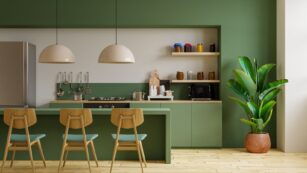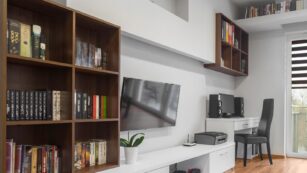
Embarking on an interior design project is exciting, but it can quickly become overwhelming without a well-thought-out budget. Interior design projects often come with many costs, from purchasing furniture and decor to hiring professionals. Creating a realistic budget helps manage these expenses and ensures you get the most out of your investment. The key is to approach budgeting strategically, taking into account various aspects of the project to avoid overspending while still achieving your desired outcome.
Setting a Clear Vision for Your Project
When budgeting for an interior design project, one of the first steps is establishing a clear vision of what you want to accomplish. Are you looking for a complete overhaul of your living room, or do you want to refresh your bedroom? The scope of your project will significantly influence your budget. Start by listing all the elements you want to include in your design. Consider the costs of materials, furniture, lighting, accessories, and any potential structural changes.
Being detailed in your initial planning will give you a better idea of the total cost and help you prioritize where to allocate your funds. Prioritizing can make a substantial difference; decide what aspects are essential and which are flexible or can be done later. For instance, you may invest more in durable, high-quality furniture while opting for budget-friendly decor pieces that can be updated more frequently.
Leveraging Technology for Budgeting
In addition to hiring professionals, consider how to use technology to your advantage. Numerous online tools and resources can help streamline the budgeting process. For instance, a savings account calculator can give you a better idea of how much you need to save monthly to reach your target budget. This tool lets you input your initial savings, desired amount, and timeline, offering a clear savings plan.
By leveraging these tools, you can set realistic savings goals and track your progress more effectively. Additionally, many interior design apps offer virtual room planning and cost estimation features, helping you visualize your project and adjust your budget accordingly. Embracing these digital tools can simplify the planning process, making it easier to stay on track financially.
Setting Aside a Contingency Fund
Another smart approach is to set aside a contingency fund for unexpected expenses. Even with meticulous planning, interior design projects can face unforeseen challenges, such as delays, additional labor costs, or higher-than-expected material prices. Allocating around 10-15% of your total budget for contingencies can provide a cushion that allows for flexibility without causing financial strain.

This safety net can also give you peace of mind, knowing that your project won’t halt if unexpected costs arise. In addition to a contingency fund, consider saving money by reusing or repurposing existing items. Instead of buying all new furniture, think about how you can refresh or reupholster what you already have. This cuts costs and adds a unique, personalized touch to your space.
Managing Labor and Material Costs
Once you have a clear idea of your priorities and a contingency fund, it’s time to look at the finer details, such as labor and material expenses. Hiring a professional designer can be a great investment, especially if you need more experience or want a polished, cohesive look. However, this comes with its own set of costs. To manage these, consider negotiating with your designer or contractor.
Some may offer discounts if you use their preferred suppliers or if you are flexible with your timeline. Be open about your budget from the start, and ask them to provide a detailed quote that breaks down all expenses. This will help you avoid any hidden fees or surprises. You can also inquire about cheaper alternatives for materials or finishes that still look high-end. Being transparent with your designer about your budget constraints will help them tailor their services to your needs.
Exploring Financing Options
Another aspect to consider is financing options. Depending on the size of your project, you should explore different financing methods, such as personal loans, credit cards, or even home equity lines of credit. Each option has its pros and cons, and it’s essential to understand these before deciding. Personal loans can provide a lump sum upfront, allowing you to manage large expenses immediately.

However, they come with interest rates that must be factored into your budget. On the other hand, using a credit card might offer rewards or cashback, but this can also lead to higher interest costs if not paid promptly. Home equity lines of credit can provide more significant funds with lower interest rates, but they also put your home at risk if you cannot repay. Carefully weigh these options against your budget and consult a financial advisor to choose the best approach for your needs.
Staying Informed About Market Trends
While planning your budget, keeping an eye on the market trends is also essential. Prices for materials and labor can fluctuate, so staying informed about these trends can help you make better decisions—for instance, purchasing materials during a sale or when a surplus can significantly reduce costs. Monitoring market changes helps find bargains and anticipate price hikes, allowing you to purchase before costs increase.
Similarly, booking contractors during their off-peak seasons might lead to discounted rates. Networking with local suppliers can also provide insider information on upcoming deals or new inventory that hasn’t been advertised yet. Keep a flexible schedule to take advantage of these opportunities and adjust your budget. It’s all about being proactive and seizing the chance to save wherever possible.
Monitoring and Adjusting Your Budget
Finally, remember that budgeting for an interior design project is an ongoing process. It’s not just about setting a budget at the start but also monitoring and adjusting it as the project progresses. Regularly reviewing your budget lets you catch any overspending early and redirect funds to where they’re most needed. Keep track of all expenses and regularly compare them against your initial budget.
If you notice a particular category consistently exceeding your estimates, it might be time to reassess your priorities or find more cost-effective alternatives. This practice will help you stay within your limits and make necessary adjustments before costs spiral out of control. Consider setting up regular check-ins with your contractor or designer to review progress and expenses. This collaborative approach ensures everyone is on the same page and working towards the same financial goals.
Conclusion
Budgeting for an interior design project involves careful planning, realistic goal setting, and constant monitoring. These steps allow you to manage your finances effectively while achieving a beautiful and functional space. Whether planning a minor update or a major renovation, having a clear budget will help guide your decisions and keep your project on track. The goal is to create a space that reflects your style and meets your needs without causing financial strain. Being strategic and flexible can make your interior design dreams a reality while staying within your budget.












